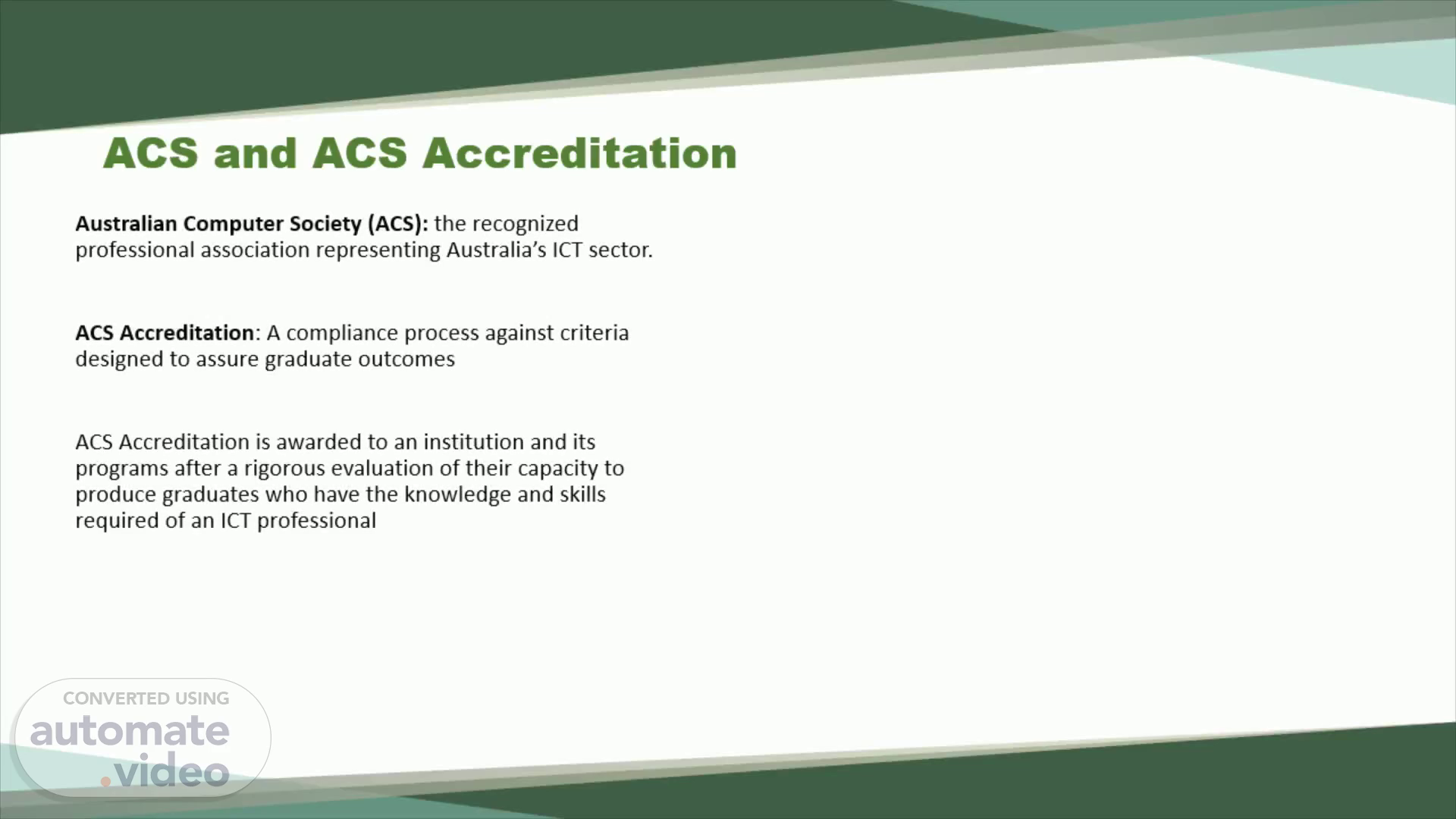
Page 1 (0s)
ACS and ACS Accreditation. Australian Computer Society (ACS): the recognized professional association representing Australia’s ICT sector. ACS Accreditation : A compliance process against criteria designed to assure graduate outcomes ACS Accreditation is awarded to an institution and its programs after a rigorous evaluation of their capacity to produce graduates who have the knowledge and skills required of an ICT professional.
Page 2 (33s)
2. Accreditation enquiry Preliminary appraisal For first accreditations (Optional program design workshops on request) A. Digital accreditation review Conducted by ACS Case Manager B. Main campus review (Plus secondary campus reviews if applicable) Case Mana er with Volunta Panel C. Accreditation outcomes ACS Accreditation Committee determination No conditions Conditions ACS accreditation process • Recommend planning 6 to 9 months ahead D. Resolution of Conditions ACS Case Manager checks any conditions are met E. Accreditation Certificate If step D applies. a temporary Conditional Certificate is issued.
Page 3 (57s)
Preparing an Application for Accreditation. 3. The panel will need access to: Institutional Context Information: Records of ICT Industry Advisory Board meetings, internal program reviews etc Copies of recent internal reviews of the ICT School and programs Program Information: Approved program objectives, content and structure design documents, current advertising material and student information Subject Information: For all subjects designated as meeting Requirements B to E of ACS Accreditation Manual: Volume 2: Accreditation Criteria, and for subjects that assess pre-requisite knowledge for these subjects subject outline documents as distributed to students examples of teaching materials and resources specifications for assignments, projects and laboratory activity, examples of formative and summative assessment materials including examination papers and scripts, graded student work including assignments portfolios, project reports, laboratory reports, professional practice log books. Of particular interest are examples of assignments which achieved the lowest pass mark, and examples of assessments low, medium and high achievement..
Page 4 (1m 37s)
4. HESF Standards Domain I: Student Participation and Attainment Sections 1.1 — 1.5 Domain 2: Learning Environment 2.1 — 2.4 Domain 3: Teaching Sections 3.1 — 3.4 Domain 4: Research and Research Training Sections 4.1 — 4.2 Domain 5: Institutional Quality Assurance Sections 5.1 — 5.4 Domain 6: Governance and Accountability Sections 6.1 — 6.3 Domain 7: Representation, Information management Sections 7.1 — 7.3 ACS Institutional Criteria 2.1 Technological resources for ICT education 3.2 ICT academic leadership, staffing & staff qualifications 5.3 ICT Industry Monitoring & review 6.1 Institutional commitment to ICT education.
Page 5 (2m 15s)
5. ICT Program A. Program Coherence ICT Skills B. ICT Job Role & SFIA Skills AQF Categories ICT Knowledge C. ICT Knowledge: - Essential CBoK - General (breadth) - Specific D. Advanced ICT Knowledge addressing Complex Computing ACS Program Criteria Application of ICT Knowledge and Skills E. Integrated & Applied ICT Knowledge & Skills F. Preparation for Professional Practice.
Page 6 (2m 40s)
ICT Program Specification. A: Program Design In order to generate an ICT professional, an accredited ICT program needs to have been designed as a coherent and integrated whole. Program Title- the title of the degree will accurately represent ICT profession Program Objective and Outcomes- t he objective needs to be appropriate within ICT - a profession for conceiving, designing, implementing, maintaining, managing and disposing of ICT infrastructure, products, processes and services within broad professional context Program Components and Structure- The curriculum will comprise an integrated set of tasks and structured learning experiences that lead to the delivery of the specified ICT educational outcomes, and satisfactory attainment of the graduate attributes. Justification of Program- There will be a justification for the program founded on the needs of stakeholders, including employers, graduates and the student intake.
Page 7 (3m 14s)
7. Example Business analysis: Level 6 Takes full responsibility for business analysis within a significant segment of an organisation where the advice given, and decisions made will have a measurable impact on the profitability or effectiveness of the organisation . Leads the selection of appropriate business analysis methods, tools, techniques; selecting appropriately from plan-driven/predictive approaches or more adaptive (iterative and agile) approaches. Establishes the contribution that technology can make to business objectives, defining strategies, validating and justifying business needs, conducting feasibility studies, producing high-level and detailed business models, preparing business cases, overseeing development and implementation of solutions, taking into account the implications of change on the organisation and all stakeholders. Guides senior management towards accepting change brought about through process and organisational change. Business analysis: Level 5 Takes responsibility for investigative work to determine business requirements and specify effective business processes, through improvements in information systems, information management, practices, procedures, and organisation change. Selects, adopts and adapts appropriate business analysis methods, tools and techniques; selecting appropriately from predictive (plan-driven) approaches or adaptive (iterative/agile) approaches. Collaborates with stakeholders at all levels, in the conduct of investigations for strategy studies, business requirements specifications and feasibility studies. Prepares business cases which define potential benefits, options for achieving these benefits through development of new or changed processes, and associated business risks. Business analysis: Level 4 Investigates operational requirements, problems, and opportunities, seeking effective business solutions through improvements in automated and non-automated components of new or changed processes. Assists in the analysis of stakeholder objectives, and the underlying issues arising from investigations into business requirements and problems, and identifies options for consideration. Works with stakeholders, to identify potential benefits and available options for consideration, and in defining acceptance tests. Contributes to selection of the business analysis methods, tools and techniques for projects; selecting appropriately from predictive (plan-driven) approaches or adaptive (iterative/agile) approaches. Business analysis: Level 3 Investigates operational needs and problems, and opportunities, contributing to the recommendation of improvements in automated and non-automated components of new or changed processes and organisation . Assists in defining acceptance tests for these recommendations..